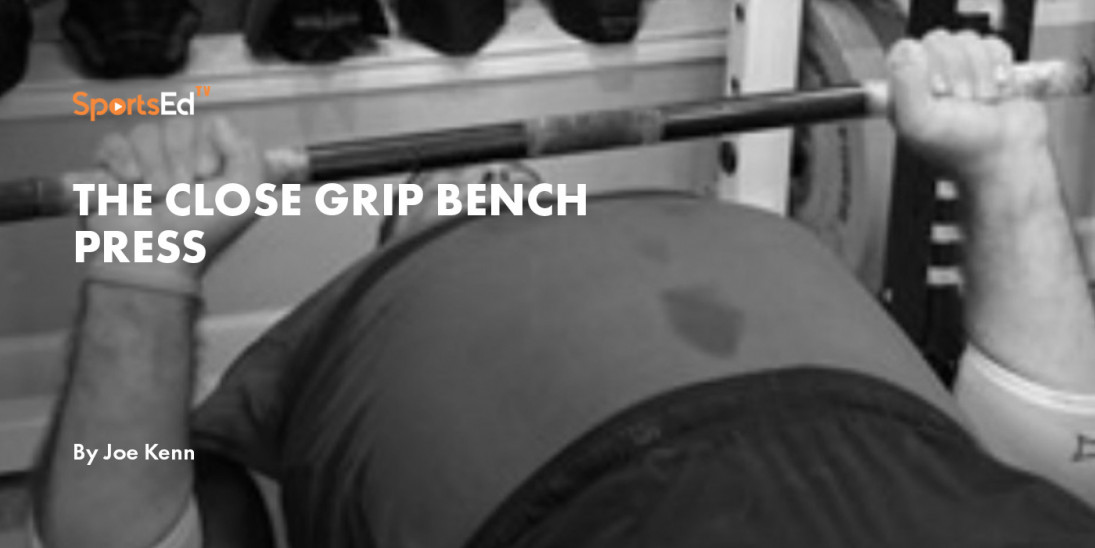Strength And Conditioning
Welcome and thanks for visiting...

The Close Grip Bench Press

Training for the aesthetics of monster triceps takes isolation movements that specifically hit the 3 heads of the triceps muscle. Training for size, as well as strength takes structural multi joint movements. The most popular structural movement for developing the size and strength of the triceps is the Close Grip Bench Press.
The biggest question from beginners to advanced is, what defines a close grip bench press? The simplest definition is anything inside your standard bench press grip. Although this has validity, if you are a competitive powerlifter or bodybuilder and use a maximum width grip, moving your hands in slightly may not give you the emphasis on the triceps you are looking for.
While a strength and conditioning coach at Boise State, in the 90’s, I developed a numbering system to use for our athletes when it came to barbell pressing movements (This system was later published in Powerlifting USA Vol 23 No 4 in 2000). This took out the guess work and allowed the coaches to prescribe specific grip ranges to emphasize triceps development.
What grip is best?
In a perfect scenario, the closer the hands are to each other the greater the emphasis on the triceps. I never recommend anything closer than two fingers on the smooth or what is classified a Grip 6 Close Grip Bench Press (see training video below). The competition grip (index finger on the ring) which is the widest allowable grip in powerlifting rules will emphasize pec development. As you move the grip closer, triceps involvement increases.
If the athlete has what is considered healthy shoulders, elbows, and wrists, Grip 6 benching should not be too taxing. If the athlete has health concerns you will have to evaluate which grip can be utilized.
Triceps strength is important in the pressing movements because it is the key to locking out massive weights. Most athletes whether it is a bench press or an overhead press miss the lift at the point where the triceps begin to take over the finishing phase of the repetition.
Grip Classifications
The Competitor's Grip
Competition Grip – The maximum allowed width between both hands based on the rules of bench pressing in powerlifting competitions. The maximum grip allowed is the index finger must cover the ring on the bar. I do not recommend the grip for athletic based strength training. This is also the grip that bodybuilders will use in training as the wider grip puts increased emphasizes on the pectoral muscles.
The Athletic Grips
Grip 1 – What we consider an athletic grip. To perform the grip 1, press the athlete places his pinky finger on the outside knurl line (points A-B, figure 1). We do a tremendous amount of Incline Presses using grip 1.
Grip 2 – Termed the modified full thumb grip. To perform the grip 2 press, place the tip of your thumb on the inside knurl line (points C-D, figure 1) and extend your thumb along the knurling. The length of your thumb is the determining factor for your grip. Unless you have extremely large hands your grip 2 distance between index fingers should be slightly closer than your grip 1 width. This is my preferred grip when having athletes perform a standard bench press.
The Close Grips
Grip 3 – Termed the modified ½ thumb grip. To perform the grip 3 press, place the mid-joint line of your thumb on the inside knurl line (the upper portion of your thumb will be on the smooth section of the bar). Extend the rest of your thumb along the knurling of the bar. The length of your thumb that is on the knurling of the bar is your grip width. This is the grip we will have our athletes take heavy singles at after performing their varied grip work out.
Grip 4 – The modified index grip. To perform a grip 4 press, place your index finger on the inside knurl line.
Grip 5 – The close index grip. To perform a grip 5 press, place the index finger on the smooth part of the bar.
Grip 6 – The close middle finger grip. To perform the grip 6 press, place the middle finger on the smooth part of the bar.
The main difference between the modified and close grips is that the modified grip has your hand placement with all your fingers on the knurling and the close grip you do not.
When we are writing a program out for our athletes the majority of the time there will be a grip number that goes with the press. For example, the athlete would perform a Grip 1 Incline Press on Monday and a Grip 3 Bench Press on Friday.
Recommendations of Programming
In past programming, I have utilized close grip bench pressing in two ways. The first choice is a standard linear plan. I would prescribe a specific grip utilized for a 4-week cycle before switching the grip width. I would work narrow to wide. The first cycle would be Grip 6 then I would work one grip wider until we reach Grip 3. I prefer this because if the training plan is solid, the athlete should be pressing some big weights at the Grip 3 cycle.
The second way I would prescribe close grip benching is a varied grip approach during the session. This is my primary choice of close grip bench pressing. The number of grips used would be determined by the total sets. This type of approach is utilized when using close grip bench pressing for dynamic effort upper body work. If I am prescribing 8 total sets, I would prescribe 4 rotating grips, 9 sets, 3 rotating grips. In this scenario, I will begin with widest grip and move in.
When we are performing our varied grip bench press cycle we usually will put the grip in front of the goal repetition.
Table 1 – Varied Grip Bench Press Work Out

I have personally had a tremendous amount of success with the “varied grip bench press” cycle, as have the powerlifters and football players I have trained. By using these closer grips and varying the distances, the athletes are getting great work because of the slight angle and leverage changes per lift. Also, as we now know, closer grips on the bench press put a greater emphasis on the triceps so your standard bench press will become stronger at the lock out. For football players this is also important, especially for linemen so they have the additional strength to lock out their opponents which I refer to as “finishing strength” (using chains and bands are also great for finishing strength).
The numbering system has cleared up a lot of confusion in our facility. We have this chart posted on our wall with all the grips and their definitions so if an athlete forgets or does not know what a particular grip is he can refer to the chart. I am a firm believer in exercise variation and by changing grips you also change the exercise. I hope this helps.
Figure 1 – Bench Grips






